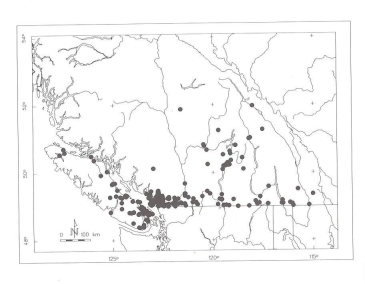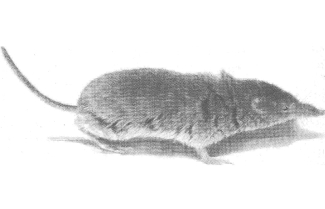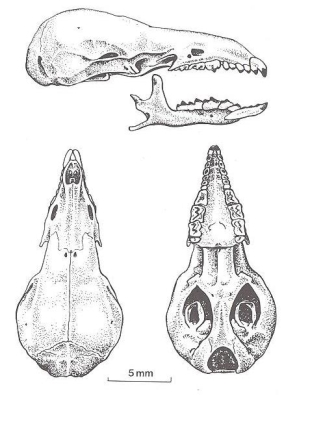In the rich low-elevation grassland habitats studied by Myrnal Hawes, males became sexually active in mid February and females in March just after completing their moult, and the first young appeared in April. The litter size ranges from two to eight, with five to six most common. The gestation period is about 20 days. Females may produce three litters in the breeding season. First-year breeding is common among females, with as many as 50 per cent breeding in the summer of their birth. Males, however, do not breed in their first summer. In the forested habitats studied by Myrnal Hawes (335 metres elevation), the breeding season of the Vagrant Shrew was shorter and females did not breed in their first summer.
At birth, the naked and blind young weigh about 0.4 grams. They develop rapidly, and by 25 days are weaned and leave the nest.
|
The Vagrant Shrew's diet is diverse. In coastal Oregon, about 30 prey types were identified, the major items being insect larvae, spiders, snails, slugs, adult and larval beetles, flies, and underground fungi. A population inhabiting montane meadows in eastern Oregon consumed mostly earthworms, caterpillars, spiders, crickets, larval and adult June Beetles, slugs, and snails. Earthworms and non-flying insects were the predominant prey in grasslands lightly grazed by cattle; in heavily grazed grasslands, flying insects and caterpillars formed the bulk of the shrew's diet. In captivity, Vagrant Shrews will cache and eat the seeds of Douglas-fir, Western White Pine, Pacific Silver Fir and Sitka Spruce. They will also consume earthworms, centipedes, small slugs, termites and the carcasses of dead mice.
|
Dusky and Common shrews coexist with the Vagrant Shrew throughout much of southern British Columbia. Although they live in the same habitats, they exhibit some differences in habitat requirements. The open grassy habitats preferred by the Vagrant Shrew are avoided by the Dusky Shrew, which is primarily a forest species in southern British Columbia. In some regions, Common and Vagrant shrews share the same habitats, but the Vagrant Shrew is uncommon at high elevations, where it is replaced by the Common Shrew.
In her forest study plot in southwestern British Columbia, Myrnal Hawes estimated peak population densities of Vagrant Shrews in late summer to be about 12 per hectare. Estimates for a population living in an old field in western Washington were much higher, with densities reaching 50 per hectare in late summer. Home range varies with habitat and season. In forested habitats of southwestern British Columbia, the average home range was estimated to be 1,039 square metres for non-breeding animals and 3,258 square metres for breeding animals. However, in the preferred grassland habitat, home ranges are smaller, ranging from 27 to 678 square metres. During the breeding season, males have larger home ranges than females and there is considerable overlap, thus increasing the chances for the sexes to come into contact. In late summer, Vagrant Shrews establish territories; individuals have discrete home ranges that do not overlap with those of their neighbours. This may ensure an adequate food supply during winter by reducing competition for food.
During summer and autumn, the Vagrant Shrew is active mostly at night. In spring it appears to have three peaks of activity: in the early evening just after dark, at dawn and in the late afternoon. Captive Vagrant Shrews were active throughout the day and night, but their activity periods lasted only four minutes. Experiments with captive animals have revealed that this shrew produces high-frequency sounds (18 to 60 kilohertz) for echolocation.
The Vagrant Shrew constructs several types of nests. Resting nests, made from grass, are 6 to 8 centimetres in diameter with a cup-shaped interior 2 centimetres in diameter. Brood nests for rearing young - 9 to 14 centimetres in diameter and 5 to 7 centimetres high - have a loose outer layer and a compact inner layer 2 to 3 centimetres in diameter that is lined with fine grass or leaves. Larger nests are constructed in cold weather.
The maximum life span is about 17 months; about 17 per cent of the young will survive from birth to the breeding season the following spring. Predators include the Western Garter Snake, Northwestern Garter Snake, Rubber Boa and owls, such as the Barn Owl, Great Horned Owl and Long-eared Owl.
|
|


